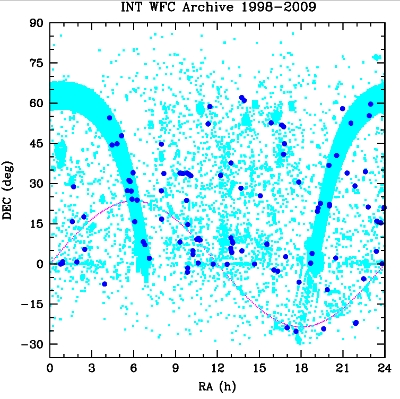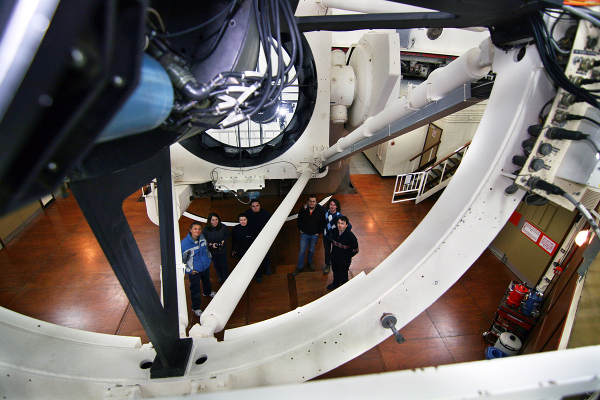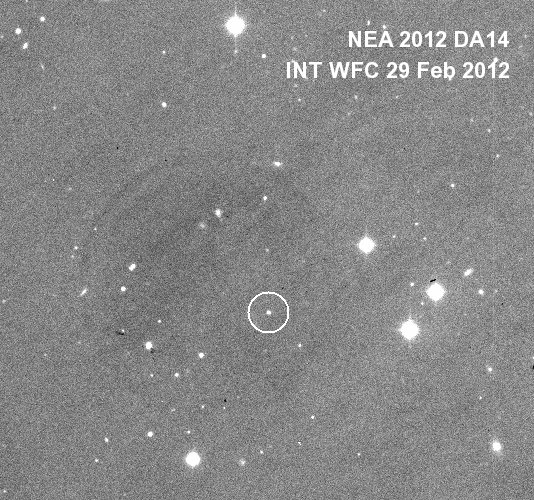ING web news release
29 October, 2013
The Isaac Newton Telescope Contributes to Near Earth Asteroid Research
Two recently published papers on Near Earth Asteroids (NEAs) demonstrate the increasing role of the Isaac Newton Telescope in precovering, recovering and discovering NEAs.
A team of 23 young astronomers, working at ING or elsewhere, and amateur astronomers, led by ING astronomer Ovidiu Vaduvescu, mined several imaging archives, observed and analysed the data, and eventually became the authors of the papers.
In the first publication "Mining the ESO WFI and INT WFC archives for known Near Earth
Asteroids. Mega-Precovery software" the astronomers used two wide-field 2-meter telescope archives to search for serendipitous findings of known NEAs in order
to ameliorate their orbits. One archive was the ESO/MPG WFI (100,000
images) and the other one the INT WFC (240,000 images), both covering all
pointings during one decade (1998-2009). In total, 152 NEA encounters,
recoveries or precoveries (encounters before the discovery date) were
carefully identified and 761 positions were measured by the team, being
reported to the Minor Planet Center. The
authors also describe the new Mega-Precovery server devoted to data mining of
known asteroids and other Solar System objects in big collections of
imaging archives, including ESO, NVO, CADC, SDSS and soon the ING
archive.
 |
Figure 1. The sky coverage of the INT archive of WFC images. Observed
fields are shown in cyan (fainter dots) and recovered NEAs in blue (larger
dots). The Galactic band has been covered by IPHAS and UVEX surveys, and the Ecliptic (where the main belt asteroid resides, but
not necessarily NEAs) is overlaid in magenta. [ JPEG ].
|
The second publication "739 observed NEAs and new 2-4 m survey statistics
within the EURONEAR network" presents the results from the
INT WFC Feb 2012 observing run (3 nights), attended by the PI and 6 Romanian students and amateurs, and data from other eight telescopes, ranging from 4 to 0.3 meters, in La Palma, Chile, France, Germany and Romania. The papers includes also
preliminary orbits and statistics for about 700 main belt asteroids (MBAs) discovered using the INT and
based on a very small 10-hour opposition survey during the 3-night run.
Using this small INT data set, the paper presents some statistics
on the total number of NEAs observable with a 2-meter telescope survey, which match
extremely well some recent NEOWISE results.
 |
Figure 2. Ovidiu Vaduvescu (ING, IAC & IMCCE; left), besides the six
Romanian amateurs and students (from left to right) O. Suciu, D. Lacatus,
A. Paraschiv, T. Badescu, A. Tudorica (both MSc/PhD students in Bonn) and
M. Popescu (recently PhD from IMCCE Paris) at the INT telescope during
the 25-28 Feb 2012 observing run entitled "Recovery of faint near
Earth asteroids having large orbital uncertainties". Photo credit: Alex
Tudorica. [ JPEG ].
|
 |
Figure 3. Animation of the NEA (367943) 2012 DA14 (discovered by the
Spanish La Sagra survey) using the INT and WFC during the Feb 2012
observing run (field of view ~5 arcminutes). The INT data
contributed to the rejection of this Virtual Impactor (VI), changing its classification to Potentially Hazardous Asteroid (PHA) and
later to the NEA class. The entire data reduction for this observing run
was done on site on a daily basis by the 6 visiting students and consisted
of image reduction, careful identification and measurement of the main
20 target NEAs plus another 1000 unknown and known mostly MBAs in some
1200 CCD images (about 6000 positions) from 60 WFC fields covering
together about 20 sky square degrees. [ GIF animation ].
|
Today we know about 10,000 NEAs,
thanks mostly to five major US-lead last two decade surveys, but some
other 10,000 NEAs can be discovered with 2-meter telescope surveys and about one
new NEA could be discovered in 2 square degrees using the INT in dark
time up to a limiting magnitude of V ~ 22.5. Nowadays, 2-meter class
telescopes endowed with wide-field cameras could play a more important role
in Solar System research, and in particular, to increase our knowledge of the NEA thread.
More information:
A copy of the papers below can be retrieved by contacting Ovidiu Vaduvescu.
O. Vaduvescu,
M. Popescu,
I. Comsa,
A. Paraschiv,
D. Lacatus,
A. Sonka,
A. Tudorica,
M. Birlan,
O. Suciu,
F. Char,
M. Constantinescu,
T. Badescu,
M. Badea,
D. Vidican,
C. Opriseanu, 2013, "Mining the ESO WFI and INT WFC archives for known Near Earth Asteroids. Mega-Precovery software", Astronomische Nachrichten, 334, 718. Paper.
O. Vaduvescu,
M. Birlan,
A. Tudorica,
M. Popescu,
F. Colas,
D.J. Asher,
A. Sonka,
O. Suciu,
D. Lacatus,
A. Paraschiv,
T. Badescu,
O. Tercu,
A. Dumitriu,
A. Chirila,
B. Stecklum,
J. Licandro,
A. Nedelcu,
E. Turcu,
F. Vachier,
L. Beauvalet,
F. Taris,
L. Bouquillon,
F. Pozo Nunez,
J.P. Colque Saavedra,
E. Unda-Sanzana,
M. Karami,
H.G. Khosroshahi,
R. Toma,
H. Ledo,
A. Tyndall,
L. Patrick,
D. Föhring,
D. Muelheims,
G. Enzian,
D. Klaes,
D. Lenz,
P. Mahlberg,
Y. Ordenes,
K. Sendlinger, 2013, "739 observed NEAs and new 2–4 m survey statistics within the EURONEAR network", Planetary and Space Science, 85, 299. Paper
|
|



